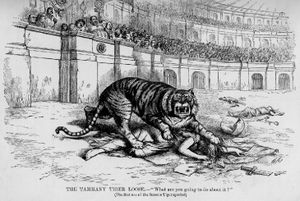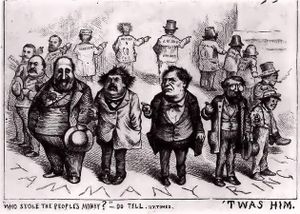I found this article on “Mother” Jones on a website, and thought you might find it helpful.
Mother Jones
How Mary Harris Jones Became the Miner’s Angel and Grandmother of All Agitators

On a warm sunny day in mid-September, I find myself drawn off the rush of Interstate 55, down a stretch of two lane highway that was once the Mother Road, Route 66. Then onto a gravel path that leads to a small cemetery. In the fields of central Illinois, this could be the sacred ground of a thousand settlements that took root in the mid-1800’s. But there is someone special here, a woman whose likeness is guarded on each side by sturdy coal miners, their sledge hammers at the ready. They are two of the thousands of “her boys.” Some are buried here in Mount Olive Union Miners’ Cemetery with the one they called their “mother,” their protector, Mary Harris Jones. She was known by another name in the U. S. Senate, “the grandmother of all agitators.”
In her 73rd year, Mary Jones began a march from Philadelphia to New York City. She was at the head of her army, several hundred textile workers, half of whom were under 16 years of age. They were on the march to see President Theodore Roosevelt, to plead for his support in ending the abominable work life of tens of thousands of Philadelphia’s children. They marched in their tattered rags, many with fingers missing from a moment’s carelessness at the loom. Sixty hours a week, week in and week out with no future. The grandmother of all agitators was on the move to fix that, for them and the almost 2,000,000 other children working in mills, mines and factories throughout the country.
She looked like such a sweet old lady, about five feet tall, with silver white hair and simple dress. But behind her plain wire spectacles were eyes that knew pain. Her husband was dead, her four children all dead of yellow fever. These sad urchins were her children and grandchildren now, and she meant to do whatever it took to get decent child labor laws. If that meant marching across New Jersey and calling out Teddy Roosevelt, well then, that’s what it would be. To those who doubted her fire, she exclaimed “I’m not a humanitarian, I’m a hell-raiser.”
She raised as much hell as she could muster in getting the public behind her and her children. When New York Senator Thomas Platt heard she was on the way to see him, he ducked out the back door of his hotel and jumped a trolley. Roosevelt engaged the Secret Service to scour the roads and rail lines to keep the mob away from him. But Mother Jones pulled a fast one. She dressed up three of the mill boys in Sunday attire and slipped on a train like any sightseeing family. They made it to the Roosevelt mansion, but were turned away with the shrug that there was nothing the President
could do. But the hundred mile march and the hell-raising speeches of Mother Jones had already done the job. Public outcry from the flurry of ongoing newspaper reports caused state after state to pass child protection laws or enforce the ones they had.
When she was 83 and could have been rocking away on the front porch, Mother Jones was thrown in jail. She was at it again, but this time for the miners, her other children, who she rallied to stand up for their rights. “Tell it, mamma. I can’t”, called back the immigrant laborers and displaced farmers struggling to eke out a subsistence living. So she did. From Colorado to the Virginias she roused the miners, then rounded up their wives and children to confront the authorities and strike-breaking workers with pots and pans. Often even the gunmen ran off more scared than the mules.
The charges against her were conspiracy to commit murder. When the coal miner’s contract expired with the operators along Paint and Cabin Creeks in West Virginia, the negotiations degenerated into a shooting war between miners and mine guards. The militia was called out three times. Mother Jones, who’d been avoiding coal company property by walking up creeks to give her speeches, was summoned, convicted with the rest, and given a twenty year sentence by a military judge.
Not deterred in the least, Mother Jones discovered a hole under the rug of the shack where she was confined, and she used it to pass letters to newspapers and congressmen about the plight of the miners and injustice of the military courts. A sympathetic soldier would crawl under the hut to retrieve the messages whenever she banged two beer bottles as a signal.
Within the month, though, she contracted pneumonia, which ironically proved to be her salvation. She was attended by Dr. Henry D. Hatfield, a practicing physician who also just happened to be the newly elected Governor of West Virginia. He quickly moved her to a private home under doctor’s care until the military court’s judgment was rescinded.
Some denounced her as “the most dangerous woman in America.”, but to her “boys” she would always be the “Miner’s Angel.” She stayed with their cause until seven months after her 100th birthday. Then she was laid to rest in the place she earlier requested, next to miners who had died in the Virden, Illinois mine riot of 1898. “I hope it will be my consolation when I pass away to feel I sleep under the clay with those brave boys.”
The monument in Mount Olive’s Union Miners’ Cemetery, 80 tons of Minnesota granite, was erected in 1936. It was dedicated before a crowd of 50,000, including 32,000 in the line of march. All were there to honor Mary “Mother” Jones, a woman who had listened to President Lincoln as he spoke, and then went on to wage her own campaign for the rights of those whom she saw as oppressed. Her headstone reads simply, “She gave her life to the world of labor, her blessed soul to heaven. God’s finger touches her, and now she sleeps.”
Links for more information:
This is a great article that brings Mother Jones to life.


